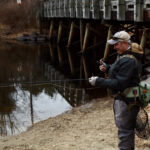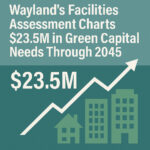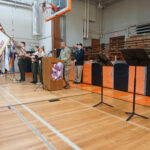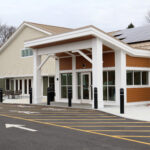Twenty-seven historical enthusiasts strolling in sweltering heat listened avidly as Gretchen Schuler shared historical facts and pointed out buildings of historical significance in a Cochituate four block area on June 22. The walking tour, hosted by Rev250 Committee and the Wayland Museum and Historical Society, was offered as part of Wayland’s Rev250 celebrations
The presentation by Schuler, a Community Preservation Committee member, began with a brief history of Wayland. It was the first settlement of the Sudbury plantation established in 1638. The eastern (Wayland) and western (Sudbury) settlements split in 1723 when they built a second parish meeting house because the western colonists complained it was too far to travel to the eastern meeting house. The settlers who were living in the eastern part were concerned about having fewer residents, so they convinced the farmers living in the Cochituate area who were not part of the original settlement to become part of the eastern settlement.
By 1780, the issue of town division arose again over a dispute about taxes. The wealthier residents in the eastern part of the settlement thought it was unfair that they were paying more than half the taxes. The split became official in 1780 with the Massachusetts legislature recognizing the eastern parish as a separate town naming it East Sudbury. The town’s name was changed in 1835 to honor Rev. Francis Wayland, who gave money to the town for the library — the first free library in Massachusetts and the second in the country.
Wayland was flourishing in the 1800s and saw its greatest growth spurt from 1875 to 1889 due to its shoe manufacturing business. The first shoe factory was built in 1830 at the corner of Main Street and Commonwealth Road. That area was referred to as the southern part of town, now called Cochituate. By 1875 Wayland had nine boot and shoe shops, employing 500 people.
Cochituate was never a standalone village; the southern part of town got its name after Lake Cochituate. The lake was originally called Long Pond. The state began construction of the transmission of water to Boston in 1845. Josiah Quincy III, the 11th Boston mayor, changed the name to imply freshness. It is a Native American name meaning “head of running water.”
The tour started and ended at the Community United Methodist Church on Main Street as Schuler pointing out buildings with historical significance because of their architectural detail or their first residents. The buildings on the tour were constructed from 1868 to 1890 and were originally owned by managers and employees of the shoe factories and their ancillary businesses.
Wayand historical fun facts shared by Schuller:
- The Methodist Church was built in 1868. The Town of Wayland asked the church elders if they could put a clock in the church tower and paid the church $50 a month rent until the 1950s. Wayland still owns the clock and paid for it to be refurbished in 2016.
- The Mansard house, named after its roof style, was one of the most popular houses in Wayland during the 1800s. There are now only two mansard houses left in Wayland.
- The Hannah Williams Playground across the street from the Methodist Church was named after the mother of 13 children. One of her children gave the land to the town, dedicating it to Wayland children. Factory owners who set up a foundation, and that foundation provides funds for the playground.
- When Shawmut Street was named, Natick residents said that the name was too classy for the area.
- In the 1880s, French Canadians represented the largest group of immigrants and comprised 20% of the population.
- The Cochituate Ball Field on West Plain Street has been a continuous baseball field since the 1860s. Baseball was a popular sport among the factory workers, and owners let employees out at noon on Saturdays to play baseball against each other as well as other towns. One of the local teams played against Harvard once and won.
- Pemberton Road was called German Hill until World War II because many of the first residents were German.
- The Wayland railroad was originally built in 1881 to transport residents into Boston. It closed in 1971.
- The oldest house in Wayland is the Noyes Harrison House, constructed in 1690 and located at the Paine Estates.















